Section of a roofing cake of a soft roof. Roof Pie Tips
I’m Michael, the director of the company, I work exclusively with roofs for more than 15 years. Below I will tell you about the intricacies and secrets of materials for the roof. There will be questions with pleasure I will answer and I will help.
Mikhail, LLC "STM-Stroy"
Surely each of us at least once in my life came up with questions about the construction of the roof. I will try to give in this article really worthwhile advice on the construction of the roof. Today we will talk about such a thing as a roofing pie.
What is a roofing cake
note
The roofing pie is a multilayer construction that provides reliable protection against various adverse factors that may occur during the operation of the roof.Such an unfavorable factor include:
- Condensation
- Heat loss
- Moisture penetration.
Each layer of the roofing cake has its own specific purpose and is closely connected with each subsequent layer.
Types of Roofing Pie
Two types of roofing pie should be distinguished: for non-insulated and insulated roofs. What is the actual difference? Let's figure it out.
Roofing cake of an insulated roof
The main task of the roofing cake when installing a cold attic is waterproofing from condensation, which can appear on the back of the tile.
This type of roofing cake should be arranged in the following sequence:
- rafters;
- waterproofing film;
- counter lath;
- crate;
- roofing.
Related Articles
Roofing cake of the warmed roof
If we talk about the roofing cake for the insulated roof, then in this case the main goal is reliable thermal insulation.

A section of a roof of this type will show the presence of the following components:
- cornice strip;
- crate;
- coating material (for example)
Now we will discuss briefly those layers of the roofing cake that are worth paying special attention to:
1. Vapor barrier insulation
A vapor barrier prevents water vapor from entering the thermal insulation.
Mount a vapor barrier film with an overlap, fasten with a connecting tape for tightness. There should be an air gap of about 2 cm thick between the film and the insulation layer.

2. Thermal insulation
Keep in mind that the insulation does not heat, but simply retains air in its fibers, i.e. acts as a heat insulator.
The main thing to consider when installing a heat-insulating layer is to prevent the insulation from getting wet because its thermal insulation properties immediately deteriorate. Related to this is the fact that it is necessary to mount thermal insulation when the moisture content of wooden roof construction elements drops to 18%.

Regarding how to properly install thermal insulation and which is better to use, you can read in this article.
3. Ventilation
When ventilating, you need to know a few tricks:
- When roofing with wavy material (slate, profiled sheet) for ventilation holes and the ridge fan, you can not be afraid.
- If you cover with more gentle material, then it is worthwhile to provide cornice ducts and ventilation outlets near the ridge (a special ventilated ridge, for example).
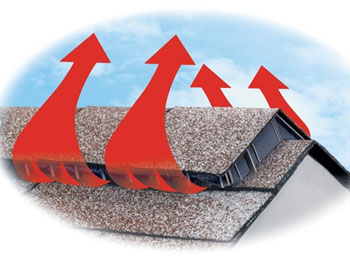
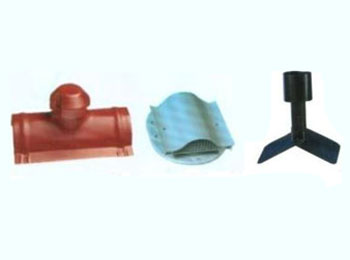
- For ventilation, it is advisable to make special holes in the lower part of the cornice.

4. Waterproofing layer
Several types of waterproofing films are judging:
1. Superdiffusion membranes. They can not be used with euro slate and metal. These membranes have a high degree of vapor permeability, so they can be mounted without a gap.
2. Waterproofing diffusion membranes. For these films, two gaps are necessary, since they are very afraid of contact with water. Applicable for roofing on a bitumen basis, as well as on tiled roofs.
Bituminous roofing materials have low thermal conductivity, but this is not enough for proper insulation of the house. As warm air rises upward with convection currents, most of the energy leaks out through the roof and attic.
When installing flexible tiles and roll roofs, roof insulation is necessary, as for any other roofs. How to make a roofing cake under a soft roof?
Cake in the construction of a soft roof
A soft roof is installed on pitched roofs and on flat ones. On pitched it is a covering of flexible tiles. In addition to the small technological nuances that depend on the brand, there is no difference in the installation of flexible tiles, and the soft roof cake looks about the same.
The arrangement of layers from bottom to top (using the example of TechnoNikol soft-roofing cake):
- inner lining of the ceiling;
- vapor barrier membrane. It has a discharge side down, away from the insulation;
- intermediate lathing (for fixing the insulation);
- stove insulation laid between the rafters;
- waterproofing (superdiffuse membrane);
- counter-lattice providing a ventilated space under the roof;
- from waterproof plywood or OSB;
- lining carpet;
- tiled finish.
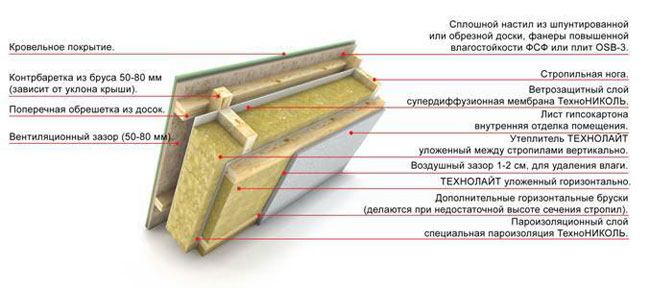
A cake of a soft roof with insulation must be good, since flexible tile is an absolutely waterproof and vapor-proof material. To do this, observe the following rules:
- the presence of a counter-lattice is mandatory. Since the main crate for soft tiles is solid, you can not put it directly on the rafters. The plywood will be adjacent to the insulation layer, there will be no space for ventilation;
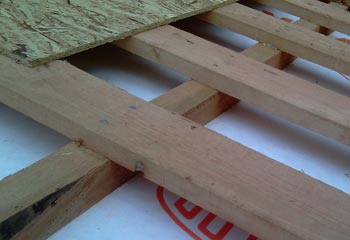

- under the aerator is installed - a rigid perforated element designed to remove moisture-saturated air from the roofing pie from under the plywood.

Installation of the cake is usually carried out in the following order:
1. The vapor barrier is hemmed with a stapler to the rafters from the attic side.
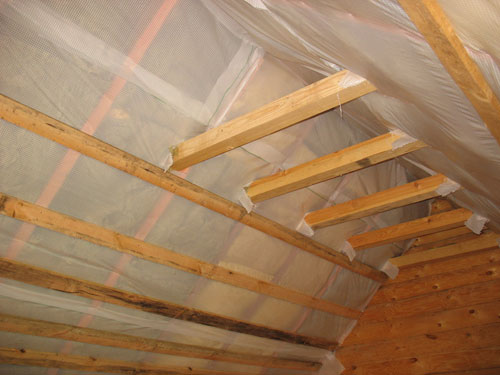
2. From the side of the roof between the rafters put in the spacer insulation plates.

3. Cover them with a waterproofing film. The waterproofing is rolled along the ridge, starting with a cornice. The upper strip is placed with an overlap on the lower one, the seams are fixed with mounting tape.
4. On top of the waterproofing on the rafters, the bars of the counter-crate are stuffed along them.
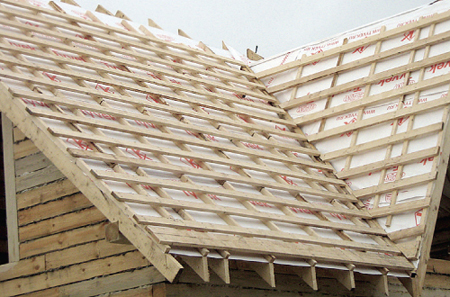
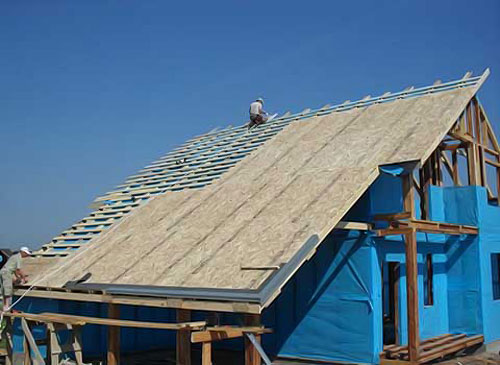

Our works
Soft Roof Pie Technology for Flat Roofs
On flat roofs, things get more complicated. There are several types of them:
- classic
For non-operating roofs There are several types of coatings;
- bulk.
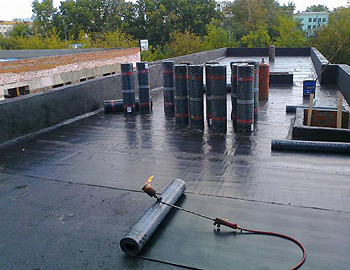
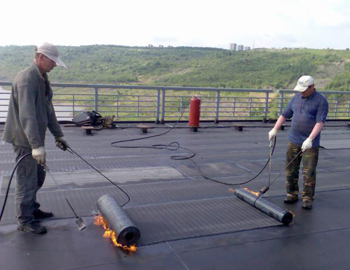
For an exploited roof, anything from ceramic tiles to lawns can be used as coatings.
There are fundamental differences in the arrangement of the soft roof cake. There are a lot of them too.
On classic roofs, the layout of the layers is:
- base (concrete slab);
- vapor barrier;
- insulation;
- waterproofing (under the surfaced roof bituminous, when installing the coating mechanically - membrane);
- topcoat.
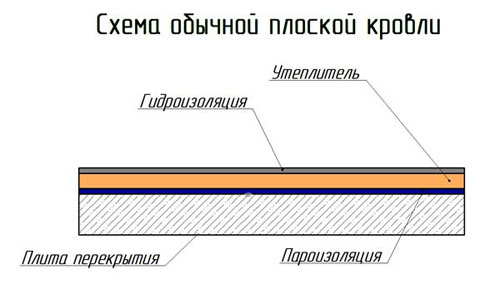
On inverted roofs, the layers change places: the insulation is placed on top of the waterproofing to protect it from damage as much as possible.

Geotextiles are laid on top. The topcoat is often made of some kind of bulk material.
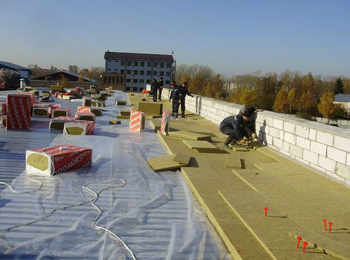

Under built-up roofs, only a non-combustible heat insulator (most often mineral wool) is used. For the rest, you can use extruded polystyrene foam: its density is greater, the layer is thinner. Not hygroscopic, unlike mineral wool.

Foam glass can also be used as a heat insulator: unlike PPS, it is resistant to high temperatures and ultraviolet, and is not inferior to other properties.
note
If you need to save money, you can make expanded clay cake for a soft roof. (expanded clay replaces slab insulation). It will cost much cheaper. But this technology has its drawbacks:
- since the material is loose, and flat roofs always have a slight slope (up to five degrees), a reinforcing mesh is installed to fix the insulation after leveling;
- for proper insulation, a thick layer of expanded clay is required;
- labor costs will be much more.
The above diagrams are approximate.
In a flat soft roof structure, a roof pie may include:
- several layers of insulation;
- cement-sand screed on top of the insulation;
- on exploited roofs designed under heavy load, lay several layers of geotextiles;
- under an exploited roof with a swimming pool - several layers of waterproofing, etc.
For example, this might look like a section of a roofing pie for an operated green roof:

- base (concrete slab);
- bitumen-polymer membrane;
- insulation;
- geotextile layer;
- profiled membrane for drainage;
- filter geotextile layer;
- lawn, plants.
As you can see, there are many features in the construction of a roofing cake for a soft roof. The design of each roof is individual, the technology is different.
Our company has more than fifteen years of experience installing roofs. We will make for you a roof tile made of flexible tiles or flat roofs in accordance with all the rules, quickly and inexpensively.
Until consumers came up against the construction of the roof, many of them believe that this same roof - there is only a roofing. In fact, the roof is a system consisting of several layers and a number of technical elements that somehow give the reliability of the whole structure as a whole.
All these layers are called roofing "pie". And like any pie, the roofing also has its own recipe, in particular the order of the layers. Most often, a roofing “pie” consists of the following layers, starting from the top: roofing material, roofing film (waterproofing), ventilation gap (there are systems with two gaps), insulation, vapor barrier, and interior decoration.
Correctly executed roofing construction is a guarantee that an ice barrier will not form on the roof overhangs in winter, and there will also be such a thing as “water return”. The thermal insulation parameters of such a roof fully comply with modern building standards. In the summer, the roofing system operates in self-cooling mode, since air movement in the under-roof gaps causes upward movement of air. Together with the air, heat emanates from the roofing material heated by the sun, as well as moisture, which the insulation may contain.
Compliance with the accuracy of the roofing cake recipe is the key to the durability of the load-bearing elements of the roof structure. At the same time, properly arranged layers will provide a comfortable life in a private house and save heat energy.
The recipes of the roofing "pie"
There are several technically justified method of roofing. Consider the two most popular ones.
In private housebuilding, two types of attics can be provided: cold and exploited. Accordingly, the roof structure in these options should be different. In the first case, only the ceiling is insulated, and the attic space itself is made ventilated so that moisture can freely leave the heat insulator. Air vents - aerators - are provided in the area of the roof ridge.
If the house has a residential attic, then the roof itself is insulated. It is in this case that a multilayer roofing "pie" is created, since the insulation and roofing material are elements of a single design. Here it is very important to strictly follow the order of all layers, since each of them performs a strictly intended function. The slightest violation of the order can negate the heat-insulating parameters of the roof as a building envelope, as well as cause premature failure of the bearing elements and even leakage.
First of all, waterproofing sheets are laid on top of the counter-lattice (options are possible when the counter-lattice is stuffed on top), turning them horizontally so that a lap of at least 10 cm is formed.At the same time, the film does not stretch, but is laid with a barely noticeable sag in case of temperature movements. Joints of waterproofing sheets are sealed.
The space between the rafters is filled with mineral wool, the slabs of which must enter tightly and in no case form gaps and voids. From the side of the room, the insulation is sewn up with a vapor barrier layer so that vapors from the room cannot penetrate into its layer. 
When arranging a roofing cake, it is important to observe ventilation gaps. It is best that there are two of them - the first between the roofing material and the waterproofing, and the second - between the waterproofing and the insulation. The height of these gaps should be at least 50 mm. The upper ventilation gap is formed by the bars of the battens with a section of 40 × 50 mm, which serve as the basis for laying the roofing material. The lower one is simply left when laying the thermal insulation, which is placed so that another 50 mm remains to the lower sag of the waterproofing.
When creating a roofing “pie”, it is very important to pay attention to such difficult places as stove and stone pipes, ventilation duct exits, roof windows. It is these places that most often become the cause of heat leaks and depressurization, the reason for which is poorly executed installation work.
Mounting Features
When installing a roof, the design of the rafter system is of great importance, in particular its type, cross-section and pitch of the rafters. All this is calculated based on the weight of the roofing, as well as wind and snow loads. For the rafter system, you should choose dry and even lumber, which must be treated with antiseptics.
 There are two types of rafter systems - with hanging and layered rafters. Hanging rafters at the top rest only on each other. This type of system is selected if the span does not exceed 6 m. For larger spans, the rafters need additional tightenings closer to the ridge. Hanging rafters allow you to create a single space under the roof without supports and walls.
There are two types of rafter systems - with hanging and layered rafters. Hanging rafters at the top rest only on each other. This type of system is selected if the span does not exceed 6 m. For larger spans, the rafters need additional tightenings closer to the ridge. Hanging rafters allow you to create a single space under the roof without supports and walls.
The roof rafters above rest on a ridge run, which in turn rests on the internal walls of the house. This solution allows the sprinklers to cover spans up to 15 m long. The roof formed by layered rafters can have fractures. With complex roof shapes or large spans, the rafter structure is reinforced with additional struts, struts and struts. Rafters, consisting of several parts of different slopes, form the so-called trusses, the configuration and cross-section of which are determined by engineering calculation. Farms allow you to cover large spans and do without additional supports. One roof does not have to be represented by only one type of rafter system.
Insulation is one of the most important elements of the roofing "pie", therefore, special requirements are made to it. It must be durable, resistant to biological destruction, have a high resistance to heat transfer, and also not to emit toxic substances and be fireproof. Several types of insulation meet these requirements, but mineral wool based on basalt confidently holds the lead among them. Glass wool and extruded polystyrene foam are still popular.
The thickness of the insulation is calculated based on temperature operating conditions. To avoid bridges of cold through the rafters, two layers of thermal insulation are provided. The first is placed between the rafters themselves, and the second on the rafters, both from above and from below. 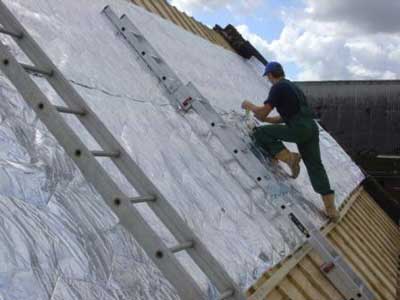
The most important condition for fibrous insulation is dryness. In order to always keep the insulation dry, it is necessary to provide for its hydro- and vapor barrier. Moisture in the thickness of mineral wool can form when temperature drops from the air. In order that it does not linger in the insulation and does not replace a cavity, making it heavier and sharply increasing thermal conductivity, it is necessary to give it a free exit. It is for this purpose that an air gap is left between the subroofing film and the insulation. The moisture leaving the insulation saturates the air and exits through the perforation of a special waterproofing film, which is used as a subroofing.
In order to isolate the insulation from water vapor tending to penetrate into it from the side of the room, a vapor barrier layer is provided, located inside. As already mentioned, humidification of fibrous heat insulators dramatically worsens their effectiveness, so the insulation needs careful insulation from moisture in any form on both sides.
In order to improve ventilation of the under-roof space, ventilated ridge strips, ventilation grilles and pipes are used.
Control zones
 Misunderstanding of the functioning processes of the technological layers of the roofing “pie” often leads to gross errors, and, consequently, to disastrous consequences. Take, for example, the situation with vapor barriers. Not all vapor barrier films have the same throughput. The cheapest pass only 30 mg / m², while a high-quality vapor barrier membrane can remove up to 1200 mg / m². Cheap vapor barrier in the heating season may simply not be able to cope with its function, as a result of which both insulation and interior decoration suffer.
Misunderstanding of the functioning processes of the technological layers of the roofing “pie” often leads to gross errors, and, consequently, to disastrous consequences. Take, for example, the situation with vapor barriers. Not all vapor barrier films have the same throughput. The cheapest pass only 30 mg / m², while a high-quality vapor barrier membrane can remove up to 1200 mg / m². Cheap vapor barrier in the heating season may simply not be able to cope with its function, as a result of which both insulation and interior decoration suffer.
When installing the roof there are no trifles. If it is said to lay the waterproofing horizontally, then this should be done. At the same time, 10 cm overlap is required, otherwise waterproofing will be unreliable. In addition, it is impossible to fix the waterproofing film with nails, but only with a stapler. Its lower edge should be led out into the gutter of the drainage system outside the eaves box; the edges of the vapor barrier are displayed on the walls. In the case of using diffusion and superdiffusion films, it also matters which side they face towards the insulation. If you confuse the sides, then from the film you can expect the same effect as from ordinary polyethylene.
Installation of a waterproofing film requires a particularly careful approach. Folds that will hold water should not be allowed; It is also necessary to ensure that the insulation does not touch the film in any place.
Insulation should be placed in two layers with offset joints. If roll insulation is used, then experts recommend that they be additionally fixed with boards every 1-1.5 meters.
On this, as the chefs say, the cooking process is over. If everything is done in accordance with the recipe, the cake will work out well.
